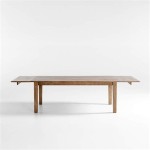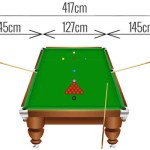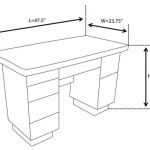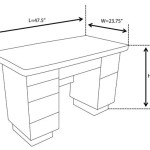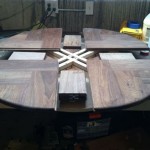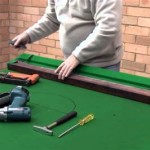Extendable Dining Room Tables for 12: A Comprehensive Guide
The need for a large dining space often arises when families grow, entertaining becomes more frequent, or simply a desire for ample room for daily meals exists. An extendable dining room table designed to accommodate 12 people offers a versatile solution, providing a comfortable space for both everyday use and larger gatherings. This article explores the various aspects of selecting and utilizing an extendable dining room table suitable for seating 12, including size considerations, materials, extension mechanisms, design styles, and practical implications.
Understanding Size and Space Requirements
Before purchasing an extendable dining table for 12, a thorough assessment of available space is crucial. While the extended table needs to comfortably seat 12, the table's dimensions in its compact form are equally important to ensure it fits the dining area without obstructing movement or other furniture. A standard rule of thumb is to allow at least 36 inches of space between the table and any walls or furniture to permit comfortable chair movement and passage. Considering the typical width of a dining chair, which ranges from 18 to 24 inches, this clearance is necessary for easy access and egress.
A dining table meant for seating 12 people, when extended, generally measures between 96 to 120 inches in length. The width typically ranges from 40 to 48 inches. In its unextended form, the table's length should be proportionate to the room size while still accommodating a comfortable number of diners, usually six to eight. For an average-sized dining room, a table that retracts to a length of 60 to 72 inches and then extends to 96 to 120 inches provides a good balance.
It is essential to physically measure the dining room area, marking out the potential footprint of the extended table. This includes accounting for the space occupied by chairs when pulled out. Using painter's tape to outline the table's extended dimensions on the floor can provide a visual representation and help determine if the chosen size is truly feasible.
Beyond the table's physical dimensions, consider the overall flow of the room. Ensure the extended table does not block doorways or create bottlenecks. If the dining room also serves as a thoroughfare, sufficient space must be maintained to allow for unrestricted movement, even with the table fully extended.
Materials and Construction: Durability and Aesthetics
The choice of materials significantly impacts the durability, aesthetic appeal, and overall cost of an extendable dining table. Common materials include solid wood, wood veneers, engineered wood (such as MDF or plywood), metal, glass, and various combinations thereof. Each material offers unique properties that influence the table's longevity and appearance.
Solid wood is highly valued for its strength, durability, and natural beauty. Hardwoods like oak, maple, walnut, and cherry are popular choices for dining tables due to their resistance to scratches, dents, and warping. Solid wood tables can withstand heavy use and, with proper care, can last for generations. The natural grain patterns and variations in color add character and warmth to the dining space. However, solid wood tables tend to be more expensive than those made from other materials.
Wood veneers consist of a thin layer of real wood applied over a core of engineered wood. Veneered tables offer a similar aesthetic to solid wood at a lower cost. The engineered wood core provides stability and resistance to warping, while the veneer adds the visual appeal of natural wood grain. The quality of the veneer and the core material are crucial factors in determining the table's durability. High-quality veneers applied to a sturdy engineered wood core can provide a long-lasting and attractive option.
Engineered wood, such as MDF (medium-density fiberboard) or plywood, is often used in less expensive dining tables. MDF is a dense, smooth material that is ideal for painting or laminating. Plywood is made from layers of wood veneer glued together, providing strength and stability. While engineered wood tables are generally more affordable, they may not be as durable as solid wood or high-quality veneered tables. They are susceptible to damage from moisture and heavy impacts.
Metal frames and legs are often incorporated into dining table designs, particularly in modern and contemporary styles. Metal provides strength and stability, and can be finished in various colors and textures. Glass tabletops offer a sleek and elegant look, but they require careful handling to prevent scratches and breakage. Combining metal frames with wood or glass tabletops can create visually interesting and structurally sound dining tables.
When selecting a table, the construction quality is as important as the materials. Examine the joints and connections to ensure they are sturdy and well-fitted. Check the stability of the legs and the smoothness of the extension mechanism. A well-constructed table will provide years of reliable use.
Exploring Extension Mechanisms and Styles
The mechanism by which a dining table extends is a key consideration. Several types of extension mechanisms exist, each with its own advantages and disadvantages. The most common types include leaf extensions, butterfly leaf extensions, and drop-leaf extensions.
Leaf extensions are separate panels that are inserted into the center of the table to increase its length. These leaves are typically stored separately and inserted when needed. Leaf extensions offer flexibility in terms of the number of diners that can be accommodated, as one or more leaves can be added to adjust the table's size. However, storing the leaves separately can be inconvenient, and ensuring a seamless match between the leaves and the tabletop in terms of color and grain pattern can be challenging.
Butterfly leaf extensions are hinged leaves that fold out from beneath the tabletop. This type of extension is convenient because the leaves are stored within the table itself, eliminating the need for separate storage. When needed, the leaves are simply unfolded and locked into place. Butterfly leaf extensions are particularly well-suited for tables with a smaller initial size, as they can significantly increase the table's length without requiring additional storage space. However, the hinge mechanism can sometimes be less sturdy than other types of extensions, and the folded leaves may add thickness to the table's apron.
Drop-leaf extensions are hinged leaves that fold down from the sides of the table. This type of extension is commonly found on smaller tables and is useful for maximizing space in compact dining areas. When the leaves are raised, they provide additional surface area for dining or other activities. When the leaves are lowered, the table becomes smaller and more space-efficient. Drop-leaf extensions are less common on tables designed to seat 12, as the extended surface area may not be sufficient to accommodate a large number of diners comfortably.
The style of the extendable dining table should complement the overall décor of the dining room. Traditional styles often feature ornate details, such as carved legs, decorative aprons, and rich wood finishes. Modern styles tend to be more minimalist, with clean lines, simple shapes, and neutral colors. Contemporary styles combine elements of both traditional and modern design, offering a balance of elegance and functionality. Consider the existing furniture, wall colors, and lighting fixtures when choosing a dining table style.
The shape of the table is another important consideration. Rectangular tables are the most common choice for seating 12, as they provide ample surface area and allow for comfortable seating arrangements. Oval tables offer a softer, more rounded look and can be more conducive to conversation. Round tables are less common for seating 12, as they require a very large diameter to accommodate that many diners comfortably. Square tables are typically used for smaller dining areas and are not well-suited for seating large groups.
The base of the table also contributes to its overall style and stability. Pedestal bases offer a modern and streamlined look, while trestle bases provide a more traditional and rustic feel. Four-legged tables are the most common and versatile option, offering stability and a wide range of design possibilities. The material and finish of the base should complement the tabletop and the overall style of the dining room.
Practical Considerations: Maintenance and Usage
Once an extendable dining table for 12 is selected, proper maintenance and usage are crucial for preserving its condition and extending its lifespan. Regular cleaning, protection from spills and scratches, and appropriate storage of extension leaves are all important aspects of care.
Regular cleaning should be performed using a soft, damp cloth. Avoid using harsh chemicals or abrasive cleaners, as these can damage the finish of the table. For solid wood tables, a furniture polish specifically designed for wood can help to maintain its luster and protect it from dryness. For glass tabletops, a glass cleaner can be used to remove smudges and fingerprints. Always wipe up spills immediately to prevent staining or damage to the surface.
Protecting the table from scratches and dents is essential, especially in high-traffic areas. Use placemats and coasters to protect the tabletop from hot dishes, spills, and condensation. Consider using a tablecloth or table runner to provide an extra layer of protection. Avoid placing heavy or sharp objects directly on the table surface. If the table is likely to be used for activities other than dining, such as homework or crafts, a protective table pad can be used to prevent scratches and stains.
When not in use, extension leaves should be stored in a dry, climate-controlled environment to prevent warping or damage. If the leaves are stored separately, consider using a storage bag or cover to protect them from dust and scratches. Ensure the leaves are properly supported and do not put undue stress on the table frame.
When extending the table, follow the manufacturer's instructions carefully. Ensure the extension mechanism is properly aligned and locked into place. Avoid forcing the mechanism, as this can damage the table. When placing chairs around the extended table, ensure they are evenly spaced and provide adequate legroom for all diners.
Consider the lighting in the dining room when using the extended table. A well-lit dining area enhances the dining experience and allows guests to see their food and surroundings clearly. Install a chandelier or pendant light fixture above the table to provide ample illumination. Supplement the overhead lighting with sconces or table lamps to create a warm and inviting atmosphere.

12 Seater Extending Dining Table Wooden Oak Ceramic

Churanty 7 Piece Extendable Dining Table Set For 6 Wooden Mutifunctional With 12 Leaf And 2 Drawers Chairs Soft Cushion Natural Wood Wash Com

Aude White And Oak Extending Dining Table For 12 14 By Robin Interiors

Aude Large Black Extendable Dining Table Round 12 14 Robin Interiors

30 Ideas Extendable Dining Table Seats 12 Extendablediningroomtableseats12 Extendablediningtablesea Comedor Minimalista Mesas De Decoración Unas

Large Dining Tables 12 20 Seats Countryside Amish Furniture

7 Pcs Extendable Wooden Dining Table Set With 6 Upholstered Chairs 12 Leaf And 2 Drawers White Modernluxe Target

Currant Dining Table Greenington

Junior Giant Console Extending Table Transformer Seats 12

Euroco 78 6pcs Classic Dining Table Set Solid Wood Extendable With Two 12 W Removable Leaves Rectangular For 6 8 One Adjustable 4 Upholstered Chairs And 1 Bench

